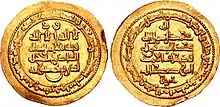Badr ibn Hasanwayh
Badr ibn Hasanwayh was the second ruler of the Hasanwayhids from 979 to 1014. He was the son and successor of Hasanwayh (r. 961–979).
| Badr ibn Hasanwayh | |
|---|---|
 Gold dinar of Badr ibn Hasanwayh, minted at Sabur-Khwast in 1005 or 1006 | |
| Ruler of the Hasanwayhids | |
| Reign | 979–1014 |
| Predecessor | Hasanwayh |
| Successor | Zahir ibn Hilal ibn Badr |
| Died | 1014 |
| Issue | Hilal ibn Badr |
| Dynasty | Hasanwayhids |
| Father | Hasanwayh |
| Religion | Shia Islam |
Biography
During the civil war between the two Buyid brothers Adud al-Dawla (r. 949–983) and Izz al-Dawla (r. 967–978), Hasanwayh had supported the latter. Following the death of Hasanwayh in 979, Adud al-Dawla invaded his territories, executed some of his sons, and installed Badr on the Hasanwayhid throne as his deputy over the neighbouring Kurdish territories.[1][2] Following the death of Adud al-Dawla in 983, Badr showed his gratitude to him by having twenty men sent to on an annual pilgrimage to Mecca in the name of Adud al-Dawla (as well as Badr's parents).[3] Like Adud al-Dawla, historians portray Badr as the ideal ruler, especially in protecting the settled farmers from his own nomad supporters.[4]
Unlike his father, Badr attended many Buyid court meetings.[5] Following the death of the Buyid ruler Fakhr al-Dawla (r. 976–980, 984–997), Badr went to Ray to help Majd al-Dawla (r. 997–1029) administer the local affairs, but his help was rebuffed. As a result, Badr kept gradually dissociating himself from the affairs at Ray.[6]
Badr was killed in 1014 by his commanders during the siege of a Kurdish fortress, due to ignoring their counsel to avoid fighting in the winter.[7] Following Badr's death, most of his domain was conquered by the Annazids, while the Buyid ruler Shams al-Dawla (r. 997–1021) took the rest.[8] Badr's grandson Zahir ibn Hilal ibn Badr attempted to restore his grandfather's position with the support of the Buyids of Hamadan.[6]
References
- Bürgel & Mottahedeh 1988, pp. 269–269.
- Bosworth 1975, p. 270.
- Tor 2017, p. 65.
- Kennedy 2004, p. 250.
- Tor 2017, p. 68.
- Kennedy 2004, p. 244.
- Spuler 2014, p. 109.
- Bosworth 1975, p. 279.
Sources
- Bosworth, C. E. (1975). "Iran under the Buyids". In Frye, Richard N. (ed.). The Cambridge History of Iran, Volume 4: From the Arab Invasion to the Saljuqs. Cambridge: Cambridge University Press. pp. 250–304. ISBN 0-521-20093-8.
- Bosworth, C.E. (1996). The New Islamic Dynasties: A Chronological and Genealogical Manual. New York City: Columbia University Press. ISBN 0-231-10714-5.
- Bürgel, Ch. Bürgel; Mottahedeh, R. (1988). "ʿAżod-al-dawla, Abū Šojāʿ Fannā Ḵosrow". In Yarshater, Ehsan (ed.). Encyclopædia Iranica, Volume III/3: Azerbaijan IV–Bačča(-ye) Saqqā. London and New York: Routledge & Kegan Paul. pp. 265–269. ISBN 978-0-71009-115-4.
- Kennedy, Hugh (2004). The Prophet and the Age of the Caliphates: The Islamic Near East from the 6th to the 11th Century (Second ed.). Harlow: Longman. ISBN 978-0-582-40525-7.
- Nagel, Tilman (1990). "Buyids". Encyclopaedia Iranica, Vol. IV, Fasc. 6. pp. 578–586.
- Spuler, Bertold (2014). Iran in the Early Islamic Period: Politics, Culture, Administration and Public Life between the Arab and the Seljuk Conquests, 633-1055. Brill. ISBN 978-90-04-28209-4.
- Tor, D. G. (2017). The ʿAbbasid and Carolingian Empires: Comparative Studies in Civilizational Formation. Brill. ISBN 978-9004349896.